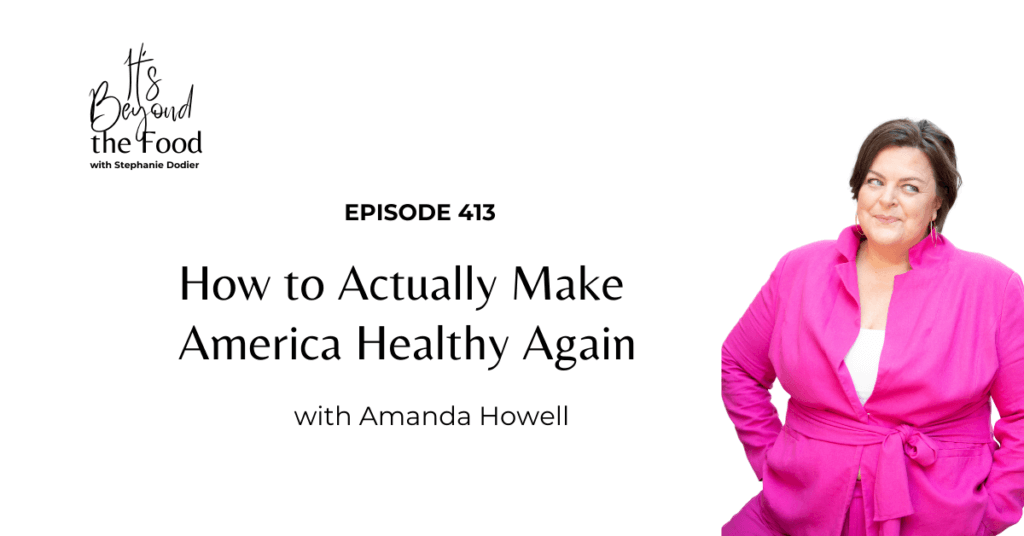How to Actually Make America Healthy Again
In this episode of the *It’s Beyond The Food* podcast, I welcomed Amanda Howell, a public health professional with a background in political science, psychology, and reproductive health. Together, we explored the “Make America Healthy Again” (MAHA) movement. This episode goes beyond slogans and dives into the systemic issues affecting health in the United States, including how privilege and policy shape outcomes. Here’s everything you need to know about making America truly healthier.
What Is the Make America Healthy Again Movement?
The MAHA movement emerged as a political campaign framed as a social justice initiative. Led by Robert F. Kennedy Jr., the movement focuses on chronic disease and other health issues. While some of its ideas, like addressing the root causes of disease and improving food quality, seem positive, the movement has garnered criticism for its oversimplified solutions and controversial policies.
Key proposals include:
– Eliminating corporate influence from health agencies.
– Removing toxins like fluoride from water supplies.
– Promoting alternative medical therapies.
– Reducing reliance on vaccines.
Though appealing at first glance, these proposals fall short of addressing systemic barriers to health, such as food insecurity and lack of healthcare access.
The Role of Social Media and Privilege in Health Messaging
The spread of the MAHA movement owes much to social media influencers, particularly the so-called “trad wives” (traditional wives). These influencers emphasize a return to domesticity, showcasing self-sufficient lifestyles with natural remedies and homegrown food.
While this content feels relatable and nostalgic, it often ignores the privilege required to sustain such a lifestyle. Growing your own food and opting for holistic remedies are simply not feasible for individuals struggling with food deserts, financial instability, or lack of healthcare.
Moreover, these influencers’ alignment with MAHA helped politicize health, tying its goals to deregulation policies that disproportionately harm vulnerable populations.
Why the MAHA Movement Misses the Mark
Health is not merely an individual responsibility—it’s shaped by systemic factors known as social determinants of health. These include:
– Access to nutritious food.
– Stable housing and employment.
– Safe living environments.
– Affordable healthcare.
MAHA’s focus on superficial changes, like banning red dye in food, does little to address these underlying issues. For example, banning an ingredient like red dye might increase production costs, which companies then pass on to consumers. This makes food less affordable for those already struggling to feed their families—without any measurable impact on overall health outcomes.
Similarly, removing fluoride from water disproportionately affects communities with limited access to dental care. Public health professionals agree that addressing systemic issues, like healthcare access and food security, is far more impactful.
The Importance of Policy in Public Health
Effective health policy must prioritize the needs of marginalized communities. Unfortunately, many of MAHA’s proposals rely on deregulation, which undermines public health protections. Deregulating food safety standards, for example, increases the risk of foodborne illnesses, while removing fluoride from water widens health disparities for low-income families.
Public health requires collective responsibility. Individual efforts to eat better or exercise more cannot overcome systemic barriers. Policymakers must focus on ensuring everyone has access to the resources they need to live healthier lives.
Moving Forward: How to Advocate for Real Health Solutions
Although MAHA may have missed the mark, we can all take steps to improve public health outcomes. Here’s how to advocate for meaningful change:
1. Educate Yourself on Social Determinants of Health: Understand how factors like income, education, and housing affect health.
2. Support Evidence-Based Policies: Push for policies that expand healthcare access, improve food security, and address systemic inequalities.
3. Hold Elected Officials Accountable: If a politician promises to improve health outcomes, demand measurable results.
4. Focus on Community-Level Action: Grassroots efforts can have a significant impact, especially in underserved areas.
Making America healthy again is a noble goal—but it requires systemic changes, not superficial solutions. The focus must shift from blaming individuals for their health outcomes to addressing the societal barriers that impact millions. Let’s work together to ensure health policies are inclusive, equitable, and rooted in evidence.
What You’ll Learn from This Podcast Episode:
In this episode, Amanda Howell provides valuable insights into how systemic factors shape health outcomes and why addressing chronic illness requires more than individual efforts. By listening, you’ll learn:
- Why the MAHA movement fails to address the root causes of chronic illness.
- How privilege influences health outcomes and shapes public discourse.
- The importance of social determinants of health in crafting effective policies.
- Steps you can take to advocate for meaningful public health reforms.
Mentioned in the show:
- People can also find Levonorgestrel pills at Target, Walmart, Walgreens, and CVS
- What is Plan B & how to use it?
For those who need abortion pills (“period pills”) now or want them on hand for potential future use:
- https://www.womenonweb.org/en/survey/22051/abortion-pills-for-future-usehttps://www.plancpills.org/https://aidaccess.org/
- https://www.plancpills.org/
- https://aidaccess.org/
What is the abortion pill & how does it work?
Abortion access, finding care, and funding
- https://powertodecide.org/get-involved/abortion-access-for-all
- https://www.abortionfinder.org/
- https://abortionfunds.org/
Master list of gynecologists who will perform tubal ligation







